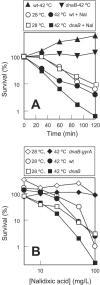Lethal action of quinolones against a temperature-sensitive dnaB replication mutant of Escherichia coli
- PMID: 16377712
- PMCID: PMC1346826
- DOI: 10.1128/AAC.50.1.362-364.2006
Lethal action of quinolones against a temperature-sensitive dnaB replication mutant of Escherichia coli
Abstract
Inhibition of DNA replication in an Escherichia coli dnaB-22 mutant failed to block quinolone-mediated lethality. Inhibition of protein synthesis by chloramphenicol inhibited nalidixic acid lethality and, to a lesser extent, ciprofloxacin lethality in both dnaB-22 and wild-type cells. Thus, major features of quinolone-mediated lethality do not depend on ongoing replication.
Figures


Similar articles
-
Effect of anaerobic growth on quinolone lethality with Escherichia coli.Antimicrob Agents Chemother. 2007 Jan;51(1):28-34. doi: 10.1128/AAC.00739-06. Epub 2006 Oct 16. Antimicrob Agents Chemother. 2007. PMID: 17043118 Free PMC article.
-
[Role of double strand DNA break repair for quinolone sensitivity in Escherichia coli: therapeutic implications].Rev Esp Quimioter. 2015 Jun;28(3):139-44. Rev Esp Quimioter. 2015. PMID: 26032998 Spanish.
-
Biochemical characterization of Escherichia coli temperature-sensitive dnaB mutants dnaB8, dnaB252, dnaB70, dnaB43, and dnaB454.J Bacteriol. 1995 Feb;177(4):1104-11. doi: 10.1128/jb.177.4.1104-1111.1995. J Bacteriol. 1995. PMID: 7532169 Free PMC article.
-
DNA replication in thermophiles.Biochem Soc Trans. 2004 Apr;32(Pt 2):236-9. doi: 10.1042/bst0320236. Biochem Soc Trans. 2004. PMID: 15046579 Review.
-
Quinolone uptake by bacteria and bacterial killing.Rev Infect Dis. 1989 Jul-Aug;11 Suppl 5:S941-6. doi: 10.1093/clinids/11.supplement_5.s941. Rev Infect Dis. 1989. PMID: 2549609 Review.
Cited by
-
Ciprofloxacin causes persister formation by inducing the TisB toxin in Escherichia coli.PLoS Biol. 2010 Feb 23;8(2):e1000317. doi: 10.1371/journal.pbio.1000317. PLoS Biol. 2010. PMID: 20186264 Free PMC article.
-
Hydroxyl radicals are involved in cell killing by the bacterial topoisomerase I cleavage complex.J Bacteriol. 2009 Aug;191(16):5315-9. doi: 10.1128/JB.00559-09. Epub 2009 Jun 12. J Bacteriol. 2009. PMID: 19525344 Free PMC article.
-
The epsilon subunit of DNA polymerase III Is involved in the nalidixic acid-induced SOS response in Escherichia coli.J Bacteriol. 2008 Aug;190(15):5239-47. doi: 10.1128/JB.00173-08. Epub 2008 Jun 6. J Bacteriol. 2008. PMID: 18539731 Free PMC article.
-
Development of Persister-FACSeq: a method to massively parallelize quantification of persister physiology and its heterogeneity.Sci Rep. 2016 May 4;6:25100. doi: 10.1038/srep25100. Sci Rep. 2016. PMID: 27142337 Free PMC article.
-
Brief antibiotic use drives human gut bacteria towards low-cost resistance.Nature. 2025 May;641(8061):182-191. doi: 10.1038/s41586-025-08781-x. Epub 2025 Apr 23. Nature. 2025. PMID: 40269166 Free PMC article.
References
-
- Caruthers, J. M., and D. B. McKay. 2002. Helicase structure and mechanism. Curr. Opin. Struct. Biol. 12:123-133. - PubMed
-
- Chen, C.-R., M. Malik, M. Snyder, and K. Drlica. 1996. DNA gyrase and topoisomerase IV on the bacterial chromosome: quinolone-induced DNA cleavage. J. Mol. Biol. 258:627-637. - PubMed
-
- D'Arpa, P., C. Beardmore, and L. F. Liu. 1990. Involvement of nucleic acid synthesis in cell killing mechanisms of topoisomerase poisons. Cancer Res. 50:6919-6924. - PubMed
-
- Drlica, K., and D. C. Hooper. 2003. Mechanisms of quinolone action, p. 19-40. In D. C. Hooper and E. Rubinstein (ed.), Quinolone antimicrobial agents, 3rd ed. American Society for Microbiology, Washington, D.C.
Publication types
MeSH terms
Substances
Grants and funding
LinkOut - more resources
Full Text Sources

